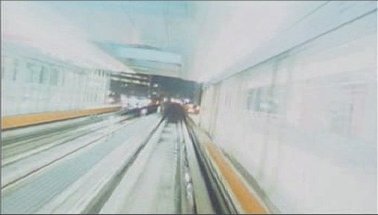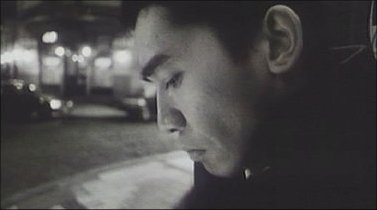|
Text and layout © Ed Shum, 2003. Ed Shum asserts the moral right to be identified as the author of this work |
|
Long Reviews |
|
This strikes at the very heart of how Happy Together is received. Clearly, the values of home grow in importance for Tony, and we feel this with undeniable poignancy. And it would be easy to criticise the film as appearing to show this as the favourable alternative to staying in a queer relationship in a foreign land. Yet, arguably, judgements of ‘favourability’ are more in the mind of the character than any overriding notion that the filmmaker is trying to push. Just as with so many WKW films, the choice cannot be simply categorised as ‘right’ or ‘wrong’ - and the uplift generated by the act of choice, of breaking a cycle, is more important than the choice itself. The final shot fuses this idea of movement, aesthetics and mood - free of judgement on the imminent reunions, personal and political, due to occur after the film’s end. |
|
Review of Happy Together (1997) |
|
|
|
...Continued... [Page 5] |
|
End |
|
The end provides a culmination of visual and sensory force - the creative energy of WKW’s direction, Chris Doyle’s cinematography and the input of production designer/editor William Chang - which has been built upon throughout the movie. Doyle’s lensing grows in the course of the film from a pared down monochrome road movie/documentary style to full colour bursts of ceaseless humanity. This reflects the transition from the literal ‘nowhere’ where Tony and Leslie lose their way on an Argentine highway, back into the urban pulse which is familiar WKW territory. Indeed, Doyle uses just about every conceivable technique, pushing saturation levels, contrasting kinetic jump-cuts with slow tracking. Time-lapse photography is used to capture the rush of a city, whilst slow-motion lingers on moments of reflection and intimacy. |
|
Complimenting Doyle’s photography is William Chang’s editing, which takes the structure of the moving image and redefines its movement. Freeze frames highlight juxtapositions to isolate the connection between characters, whilst lowered frame rates lock individual moments into fractured time-spaces. It might have been fair to say it was ‘[WKW] business as usual’ on the visual side of things, were it not for the fact that the spectacle of the image finds perfect conjunction with the feel of the story - at times giddy and hopeful, at other times painful and mired. |
|
Music usage is not only inspired, but also one of the most accomplished aspects of the film. While most WKW films have memorable music which evokes emotion by association and recollection, the music in Happy Together seeps into the consciousness beautifully, without being quite as prominent as in Chungking or ITMFL. Astor Piazzolla tangos provide perfect rhythm, straddling the gap between melancholy and beauty, whilst Frank Zappa makes an incongruous yet fitting bridge between modern rock and roll lifestyle and personal contemplation. The combination is handled maturely, and whilst ITMFL uses repetition determinedly, almost as a conceptual device, the repetition is subtle in Happy Together, and leaves you wanting more. |
|
There is also a sense of maturity in WKW’s focus, the use of a stripped down narrative being a precursor to ITMFL. Western reviewers note that the movie is less ‘goofy’ than Chungking or Fallen Angels, but those two films actually engender (brilliantly) a sense of fun which is quite rare in the rest of WKW’s catalogue. The difference between Happy Together and, say, Days is that there is less a sense of mystery about the characters in Happy Together. Whilst WKW has always eschewed needless explanation, more recently his characters no longer defy description - which is not a positive or negative development in itself. This is maturity, of which further can be seen in ITMFL. |
|
The pulse: scenes of transit have a prominent effect on the mood of WKW’s films. This final shot evokes motion and energy more than destination and resolution - a characteristically untraditional manner of viewing a homecoming |
|
Speaking of development, the links which are provided in Happy Together to other works by WKW, past and future, are manifold. These include structural echoes, such as the repetition of a concept/image. Indeed, the epilogues in suddenly different settings, with the idea of leaving a secret/sadness in a briefly visited foreign land - these ideas are explicitly referred to again in ITMFL. The ITMFL connection is also apparent in the motifs centering around the characters: Maggie’s ‘we won’t be like them’ from the latter film being a development of Tony’s realisation in Happy Together that ‘we are all the same’ (poignantly [mis]embellished in the translation - with subtitles allegedly by Tony Rayns - as ‘lonely people are all the same’). Other moments also find reference in ITMFL, such as the occurrence of ambiguous telephone calls with no definitive reciprocation, and the insertion of newsreel footage. |
|
On instants of referring back to previous works, one may note, for example, the slow motion of Tony eating a mouthful of rice compared to his coffee scene in Chungking. Or the belated poignancy of a filial theme as in Fallen Angels. Or Chang’s ‘never been there, [so it must be] good’ attitude to new horizons mirroring Faye in Chungking. Certainly, it’s true to say that WKW’s movies work as developments on each other; certain aspects jettisoned as time goes by, others studied more closely. In this film some of the hinted at tragic aspects of earlier works are looked at more closely, relegating the role of exhilaration (before it was excised altogether in ITMFL) to moments of defiantly contra-narrative mood isolation. |
|
|
|
Streetlight: Tony’s performance is a true revelation. He was eventually (Cannes) honoured for ITMFL, yet it’s arguable as to which film features the better performance. The coded depths of his depiction in ITMFL (a necessary effect of WKW’s crafting of emotional ellipsis) contrast Happy Together’s fiery turns of moody but brilliant angst - truly, both performances deserve acclaim |
|
As to the performances in the film, Tony Leung’s is genuinely moving. He has an assured talent for blending ambiguity with seething, yet understated angst. There are some very subtle nuances, for example in Tony’s voice as he moves between nonchalance and vulnerability. At times, his character is called upon to stretch audience understanding, particularly in WKW’s imposition of a violent side to his character (perhaps an over-emphasised reading of ‘gay dysfunction’?), yet Tony handles this flawlessly. Even when we may question his motives for withholding Leslie’s passport, Tony is still convincing. |
|
Though Leslie’s acting is great too - we expect(ed) nothing less from one of Hong Kong’s best talents - unfortunately his character often falls into something approaching a parody of the popular Leslie persona: needy, ungrateful, bitchy. Whilst these qualities have been built upon for some of Leslie’s most memorable performances (e.g. Days), there are scenes (like when he literally slinks out of a clients car, all celebrity smarm) where the feel isn’t quite as profound as usual. As mentioned before, the film seems to ‘open out’ with his character’s absence - a comment on how WKW has structured the influence of the character on the mood of the film, rather than on Leslie’s performance. Being the last film of Leslie’s I saw, there is a double poignancy in seeing two sides to his character: the childish face of the restless playboy as well as the grown man who portrays pain in frustrated regret - only too late. |
|
|
|
Page: |
|
Page: |

